Kwei Quartey's Blog, page 11
April 26, 2014
CRIME FICTION:THE WORLD TOUR
Join me on my A-Z of the places in the world in which crime fiction is set. Many of the authors who put their stories in these locales publish with Soho Press, famous for its international cast of authors. A is for ALASKA Award-winning John Straley writes in and about the larger-than-life state of Alaska. His latest novel is Cold Storage, Alaska, which has been incredibly well-reviewed and received. The first question I had was, “Is Cold Storage a real place in Alaska?” Apparently not. I search-engined it and didn’t find it. I was a little disappointed because I was hoping I could add to my items of trivia and be able to say to people, “Did you know there’s a place in Alaska called Cold Storage?” Anyway, it turns out that John Straley’s hometown is Sitka, Alaska where he works as a criminal defense investigator and lives with his wife Jan in a bright green house on the beach.

CRESCENT BAY, SITKA (Source:Shutterstock)
I’ve never been there myself, but Sitka is obviously lovely and scenic, as in the example below. The guy in the picture is not John Straley.

VIEW ACROSS SITKA SOUND FROM MT. VERSTOVIA (Source: Shutterstock)
As one might expect, crime in Sitka is low. In 2012, there were zero murders and only one robbery–yes even in bustling downtown.

LOVELY DOWNTOWN SITKA (Source: Shutterstock)
Alaska used to belong to Russia, but became part of the US after the Alaska Purchase treaty was negotiated, concluding at the ungodly hour of 4 a.m. on March 30, 1867. The transfer ceremony took place at Sitka on October 18, 1867. Thank goodness Russia was broke. Or else we might not have John Strayer.
Next: A is for AUSTRALIA
April 17, 2014
E-READERS AND THE RUMORED DEATH OF PAPER
For some time, the doom and death of paper books–hardcovers, paperbacks–have been predicted with the arrival of e-readers and e-books. However on my recent trip to Stockholm, when I deliberately observed passengers reading in airports and on the plane to get a sense of how many Kindles and other e-readers were in evidence, I was underwhelmed. On none of the flights or airports did I see people with e-readers, but there were plenty of paperbacks and hardcover books in evidence. In addition, I was happy to see a few men reading novels. When it comes to reading fiction, men fare badly in comparison to their female counterparts.
It should be said that although e-readers don’t seem as popular in Europe and Scandinavia as they are in the USA, their use may be on the rise. On the Stockholm buses and subway trains I rode however, I didn’t see Kindles in evidence. In the UK recently, Tim Waterstone of the successful Waterstones book retailer has predicted that the physical paper book is not going anywhere anytime soon, and in fact seems to be suggesting that it is the e-book that’s on the way out.
Look, I like things with screens and buttons and keyboards and the like, but the recent joy of the senses I experienced when my carton of personal copies of MURDER AT CAPE THREE POINTS first arrived and I took one out and relished the sensation of the glossy cover, the almost 3D quality of the jacket cover image, the incomparable smell of new paper and the sound of pages turning cannot ever be reproduced by a Kindle.

A solid, satisfactorily heavy carton of 24
The e-reader definitely has its uses–lightening the weight of your backpack or luggage, for example.

TRUE: A TABLET CAN HOLD A MULTITUDE OF BOOKS FOR A FRACTION OF THE SPACE AND WEIGHT
(Stock photo, Shutterstock)
But so too does a microwave oven have its benefits, but who’s predicting that conventional stovetop cooking is going away anytime soon?
April 4, 2014
NEW CONTEST

GET CLOSE TO CAPE THREE POINTS:WEAR IT
A new contest is on, and the prize is one of the T-shirts shown above in sizes, M, L and XL. Supplies are limited. There are two ways to enter to be eligible to win:
1) The next four people to write a review of MURDER AT CAPE THREE POINTS to appear on Amazon.com, powells.com, BN.com or any other bookseller’s site will win a MAC3P T-shirt. Let me know when you have posted it so I can look out for it.
2) Alternatively, on Twitter, follow me @kwei_quartey and tweet your best “twitter pitch” for MURDER AT CAPE THREE POINTS–a couple of lines that hooks you in and gives a good idea of what the novel is about. Hashtag #MAC3P
Good luck!
March 23, 2014
BOOK EVENTS
CERRITOS LIBRARY
On Sunday March 16 2014, I joined fellow authors Natalie Baszile and Terry McMillan for a presentation, panel and book signing at Cerritos Library in Southern California.

Cerritos Library has been ranked as one of the 100 most beautiful libraries in the world
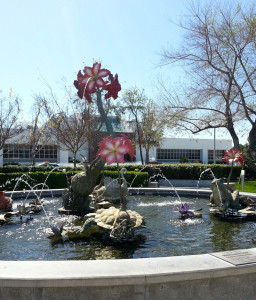
Water fountains–a nice adornment

Lobby outside the Skyline Room where the event was held

With Joyce Norwood, one of the organizers of the event

Attendees in the Skyline auditorium
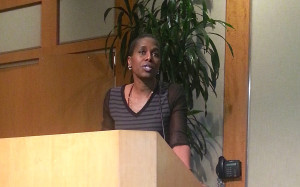
Natalie Baszile, who has a wonderful debut novel called Queen Sugar
[image error]
The incandescent Terry McMillan, her new novel is “Who Asked You?”
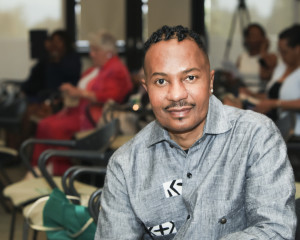
Me

Audience enjoying a wisecrack by Ms. McMillan
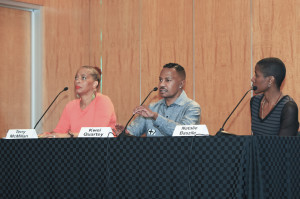
Panel discussion
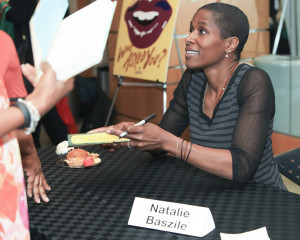
Natalie signing

Me signing
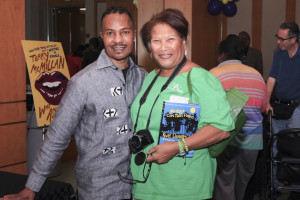
Happy customer

A lovely bevy of ladies
VROMAN’S BOOKSTORE SIGNING
March 22, 2014
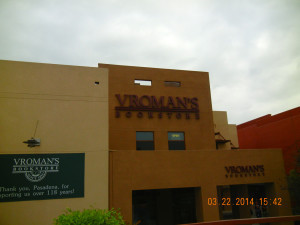
VROMAN’S, 118 YEARS OLD, IS THE LARGEST AND OLDEST INDEPENDENT BOOKSTORE IN SOUTHERN CALIFORNIA
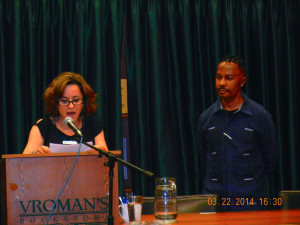
INTRODUCTION BY CONNIE, THE MODERATOR
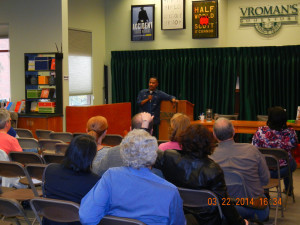
DISCUSSION WITH AUDIENCE
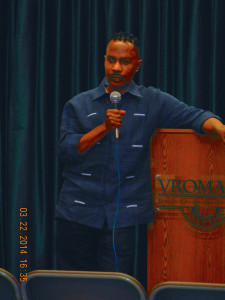
TAKING A QUESTION
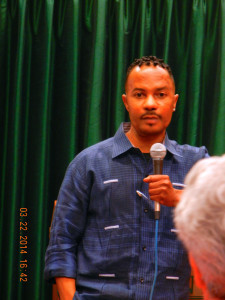
MORE DISCUSSION…
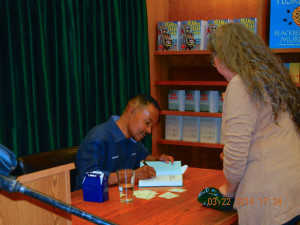
SIGNING BOOKS
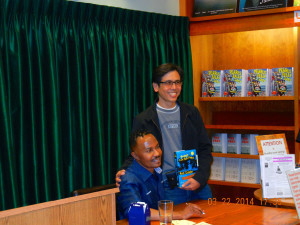
WITH A READER AND FRIEND

MY GUESTS GOT A CHANCE TO TRY MALTA, DARKO DAWSON’S FAVORITE BEVERAGE…

…AND TRY THEIR HAND AT THE MBIRA, A TRADITIONAL AFRICAN INSTRUMENT THAT DARKO PLAYS
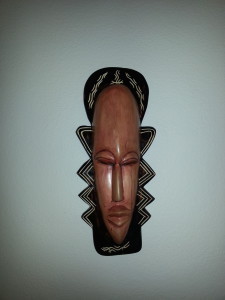
AN AUDIENCE MEMBER WON THIS LOVELY AFRICAN MASK BY ANSWERING A QUIZ QUESTION CORRECTLY
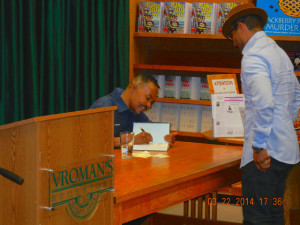
ANOTHER READER AND FRIEND
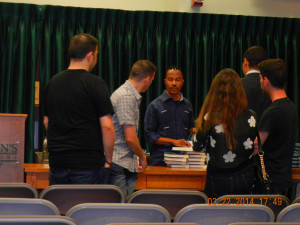
MY VERY GOOD FRIENDS REPRESENTIN’
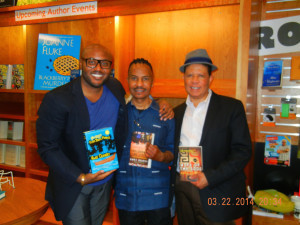
WITH BROTHER (R) AND COUSIN (L)
Next on the calendar: National Black Writers Conference on March 29, 2014, reading with Mukoma Wa Ngugi
February 26, 2014
THE ERA OF MAC-3P HAS ARRIVED
The onset of the era of MURDER AT CAPE THREE POINTS was signaled by the arrival at my doorstep today of a box of 24 hardcover personal copies shipped from Random House, which acts as the distributor for Soho Press, my publisher.

A SOLID, SATISFACTORILY HEAVY CARTON OF TWO DOZEN BOOKS
We have been seeing the design now for months, but on the real jacket cover it is very striking, and twice as nice as the advance reading copy. The finish is glossy and smooth.

JACKET ILLUSTRATION BY KATHERINE GRAMES; DESIGN BY JANINE AGRO, SOHO PRESS
The front flap has a matte finish:

SOHO PRESS’S WELL-KNOWN ATTENTION TO DETAIL, EVEN ON THE FRONT FLAP WITH STORY SYNOPSIS
The title page has that iconic image of coconut palms. The jaunty title seems to follow the inflections of the trees:

CLUSTERS OF COCONUT PALMS ARE COMMON ALONG THE CAPE THREE POINTS COAST
The prologue page, where the story launches–and quickly:

FONT IS MEDIUM-SIZE WITHOUT UNNECESSARY WASTE OF SPACE
Back flap with author photo by James DePietro:
[image error]
THE BLANK SHEETS AT THE VERY BEGINNING AND END OF THE BOOK ARE SKY BLUE; THE GLUED PAGE OVER WHICH THE FLAP FOLDS IS CALLED THE “PASTEDOWN.”
The back cover has blurbs available before the printing, but there have been several blurbs and reviews since then that will likely be included in a second printing, inshallah:
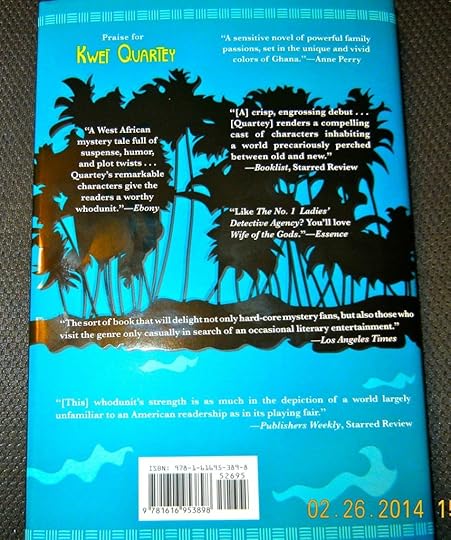
SOHO GETS AN A+ FOR THE COVER DESIGN
Soho is also known for their quality bindings. Their book spines are distinctive even without the jacket covers:

FOLLOWS THE BLUE AND YELLOW MOTIF
Some of these personal copies will be sent free as promised to readers who were new signups to my website, but follow me on Twitter and find out how you can be eligible for some more free copies.
February 17, 2014
PICTURE TOUR OF A DEEP SEA OIL RIG
After landing at the West Leo oil rig, we had a safety briefing in the heli admin lounge. That’s SOP for any arriving crew. Then I was shown around by our guide, Nick Howell, accompanied by drilling engineer supervisor and friend, Fraser Lawson. Those who read my new novel MURDER AT CAPE THREE POINTS will be able to relate to some of the oil rig landmarks described in the novel after viewing the photo presentation below.
(All photos by West Leo Performance Coach, Nick Howell.)
[image error]
“MOON POOL,” THE LARGE OPENING TO THE SEA, WITH THE DRILL PASSING THROUGH IT TO THE SEABED

IN MURDER AT CAPE THREE POINTS, THE OPERATOR OF THIS TYPE OF CRANE SPOTTED TWO DEAD BODIES IN A CANOE FLOATING AROUND THE RIG
[image error]
WITH FRIEND AND DRILLING ENGINEER FRASER LAWSON, STANDING IN FRONT OF STACK OF “RISERS,” WHICH ARE THE CONDUITS CONNECTING THE OIL WELL IN THE SEABED TO THE SURFACE DRILLING FACILITY

THIS IS THE HELIPAD, WHERE THE HELICOPTER LANDS AND TAKES OFF WITH BALLETIC PRECISION. THE MASSIVE DERRICK, HOUSING THE DRILL ASSEMBLY, TOWERS BEHIND ME

I THINK I MIGHT BE ENJOYING MYSELF
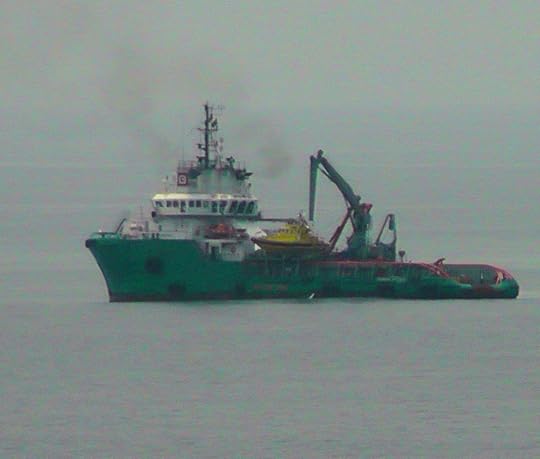
A SUPPLY VESSEL FROM SHORE APPROACHES THE RIG. AMAZINGLY, FISHERMEN FROM COASTAL COMMUNITIES VENTURE OUT THIS FAR IN THEIR CANOES, AND FATAL COLLISIONS WITH SUPPLY VESSELS HAVE OCCURRED. AS IS EVIDENT IN MURDER AT CAPE THREE POINTS, RIG CREWS ARE NOT SANGUINE ABOUT THE FISHERMEN’S PRESENCE

EACH LIFEBOAT CAN HOLD 120 PASSENGERS, BUT IT IS A TIGHT SQUEEZE
There were many other areas that I saw that are not pictured here, e.g. the cement room, galley (cafeteria), doghouse (monitoring of drilling activity), mud pump floor (mixing of fluids used in drilling), shaker house (straining of fluids to remove the drilling pieces sheared off), the sick bay (run by an MD, just like in Murder at Cape Three Points), and all the company offices. After a visit like this, one has to respect the incredible complexity of oil drilling and the people who are in charge of it.
February 9, 2014
THE REAL HELICOPTER–AND NO WATER LANDING: (Part Two)
As we approached the helicopter for boarding, the propeller(s) had already started up. It’s made very clear that one must never approach from the front or the back of the helicopter, or carrying a tall object vertically. They don’t call them “choppers” for nothing.
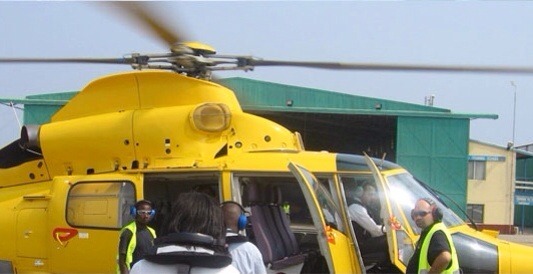
APPROACHING THE CHOPPER (Photo courtesy of Tullow Oil)
The noise level is high, so ear protection acoustic headphones should be on already at the time of boarding. Sharp-eyed attendants are on hand to chaperone you toward the craft and prevent you from straying from the path, just in case you suddenly have a bright idea you’d like to head toward the nose or tail of the helicopter. Attendants also help strap you into your seat in the four-point belts that I was now familiar with from my training. This particular NHV Helicopter seats eight in two rows of four abreast, one in front, and one behind. On the outgoing journey I was in the back row, and on the return, I was in the front. It made quite a difference, which I’ll explain later.
There are usually two pilots in the cockpit, in our case the captain–the graying, obviously more senior one, and a younger copilot, both white males. The captain made a routine welcome announcement, similar to that made on a commercial airliner, which came out thin and scratchy in our earmuffs. The two pilots made double checks on all the controls, flicking a bewildering array of switches and levers and communicating with each other via their headphones.
Then, with a thumbs-up to the ground marshall (the person who gives those fancy hand signals to the pilot), we were ready to go. Like Darko, I was barely aware that the chopper had lifted off the ground, so gentle and imperceptible was the motion. I only fully realized we were up when we magically swiveled to the right and moved toward the runway, where we turned left and hovered again. Accustomed to the forward-ever-backward-never motion of an airplane, the sensation of being stationary in mid-air as if suspended by invisible cables attached to the roof of the sky is really spectacular. And then with a slight genuflecting dip of the helicopter’s nose, we moved forward smoothly as if gliding along a slick, lubricated rail.
I was at the right-side window, so I had a terrific view of Takoradi the city as we rose in the air. As Darko noticed, it’s a patchwork of buildings and still a lot of green space–much more than Accra. It seems I missed a good view of the harbor, which I might have seen if I had been sitting on the port (left) side. I had thought we would immediately head out to sea almost perpendicular to shore, but in fact we followed the coast closely for about 15 minutes before switching direction. I’m glad that’s the way it was done, because I was able to view the three peninsulas that give Cape Three Points its name. Even more fascinating, I saw the southernmost tip of Ghana, a diamond-shaped piece of land surrounded on all sides by fluffy white surf. This is the land mass closest to zero longitude (the Greenwich Meridian), zero latitude (the Equator), and zero sea level–or the “land nearest nowhere.) I would have loved to have photographed this, but picture-taking was disallowed without prior permission of the captain, which I had not arranged.
Higher up, above the clouds, visibility was reduced and the view of the Atlantic Ocean was hazy, nothing like that described in Murder at Cape Three Points, although I did spot a few trawlers or possibly supply vessels going to or coming from the rig. Fraser also pointed out to me the floating, production, storage and offloading (FPSO) tanker called the Kwame Nkrumah, after Ghana’s first president and pan-Africanist.
Within some 45 minutes or so, the oil rig came into view, and we rotated about 90 degrees to make the approach to the helipad, marked appropriately with a big “H” which I assume might be useful in stormy conditions where visibility is impaired. Not in this case however. Unlike the tumultuous North Sea, the Gulf of Guinea is calm and well-behaved. As we approached, the helipad transformed from its toylike appearance when viewed from afar to the huge platform it is in reality, and once again we were hovering in mid-air, this time over the “H.” Then, with the delicacy of a lady, it touched down.
Next: touring the West Leo rig, which in Murder at Cape Three Points is described as a creature “afloat on powerful, squat limbs, it’s gangly crane booms resembl[ing] tentacles.”
February 7, 2014
THE REAL HELICOPTER–AND NO WATER LANDING: Part One
In MURDER AT CAPE THREE POINTS, the opening scene takes place around an oil rig some 37 miles off Ghana’s coast. There are two dead bodies in a canoe and therefore it is a crime scene. How did the bodies get there? As thorough as he is, Inspector Dawson decides he must visit the rig, even though he has a deadly fear of water and must go through the BOISIET. Following my principle of “experience everything my characters do” (except the whole murder thing), I too wanted to visit a rig.
The first Monday morning in Ghana, not 24 hours after I’d arrived, was the day I was to hopefully not use my newly learned escape procedures (see previous blogs). I was ready for my expedition to the West Leo oil rig in the Gulf of Guinea: BOISIET certificate, check; OGUK medical certificate, check; passport, check. We were to fly from Accra, the capital of Ghana, to Takoradi, from which airport base the helicopters make their flights to and from the rig.
At six thirty sharp, I was picked up and shuttled to the Accra’s Kotoka Airport accompanied by Fraser, a friend of mine and senior drilling engineer who helped me with the technical details in the novel, and another “PR” visitor to the rig. The oil company has its own check-in area at the airport domestic terminal, but that doesn’t mean that all the normal security screening procedures aren’t carried out rigorously. Everything is by the book. The passengers were all rig workers going to different deep sea installations off the Cape Three Points coast.
The aircraft, a two-propeller Beech 1900D, seats about twenty-two people, so with about eighteen passengers, was lmost full. If I had any doubts about the power of the Beech, they were dispelled as the little plane made its takeoff run and had me flattened against my seat. Forty-five minutes later, we landed at the airport in Takoradi. As you can see from the photo below, it’s a very small airport, but it has historical importance in that it was used by the Allied Forces during WWII as an assembly station for military aircraft that flew across the vast Sahara desert to reach Egypt, since Germany and Italy had the Mediterranean blockaded. Although this isn’t generally known, the “Takoradi Run” made a significant contribution to winning the war.

TAKORADI AIRPORT (Photo by Puneetsharma, Panaromio)
If the security screening was up to standard at the Accra airport, it was above that at Takoradi, in some ways because the airport is on a military base. My BOISIET and medical were examined, and along with the rig workers, I was prodded, patted down, magic-wanded, the whole nine. Everyone is required to watch the safety video before boarding the helicopter. The video went over much of the same principles to which I had been introduced during my BOISIET classes. Then we donned our life jackets and headed for the helicopter.

NHV HELICOPTERS COMMONLY USED BY OIL COMPANIES (Photo courtesy Tullowoil.com)
January 26, 2014
HOW TO ESCAPE FROM A SUBMERGED HELICOPTER–Part 2 Life imitating art
In my prior post, I talked about my upcoming visit to an oil rig during my trip to Ghana February 2 – 14. To do that, I need to have certain certifications and authorizations. The first is a medical exam by an OGUK physician. This is a specific oil & gas industry exam that you won’t find at any ol’ clinic. The closest such physician to me is in San Diego, California, about 120 miles away. So last week I made the 2-hour trip there from Pasadena where I live. The examining physician gave me a clean bill of health, including, it seems, very good hearing acuity, which is part of the required testing.
With that taken care of, I moved on to the second step, which was to take the BOSIET, an internationally recognized 3-day course that bestows a certificate valid for four years. Although there are small differences in the course content between different training centers, a certification from say, Australia, would be recognized in the US or Ghana, etc. These centers are about as few and far between as the OGUK providers. I chose Falck Safety Services in Houston, flying in on Sunday, January 19, a day before the start of the course. Falck, a Danish company founded by Sophus Falck, has a wide global presence, and is one of the world’s biggest security and emergency services corporations. Running six training centres in Louisiana and Texas, it is the leading provider of safety training and offshore services primarily to operators in the Gulf of Mexico.

LOBBY AT THE HOUSTON FALCK CENTER (Photo: Falck.com)
In the company of oil & gas veterans
At 7:30 AM sharp Monday morning, we began the first full day of BOSIET. Including me, there were fourteen attendees–I’ll call them “trainees” for lack of a better word. All except me were connected in some way to the oil and gas industry, and it seemed that all, with perhaps one or two exceptions, had worked on oil rigs associated with multinational companies like Chevron, Exxon, Haliburton, Baker Hughes, Schlumberger. Many of the trainees were very experienced in their fields. An engineer who sat a few spaces from me and who was one of the only two women present, had been stationed in multiple regions of the globe, including tough environments like Nigeria where the accommodations were difficult and security was tight. Sitting to my left was a young guy, Nat, shortly to be posted to a petroleum exploratory vessel off New Zealand, which country is famous for being the location for the film The Hobbit. Nat appeared to have worked in every possible type of oil installation the world over and had been in several different kinds of emergency situation. To my right was a man who would be going off to Angola almost as soon as he was done with the course. The age range of the attendees I would say was early thirties to mid-fifties.
It was clear that I was the only one of my kind in the group. A physician-author in the midst of oil and gas workers was definitely something of a curiosity, although one of the instructors told me that they had once a student who was a local journalist doing research on the Falck course. I might pause here to state what is pretty obvious: I was far out of my comfort zone and doing something that I didn’t really have to. The other trainees were mandated to be there by their companies, which were paying the somewhat hefty fee for the course. The chance of my ever going into oil and gas is about as close to zero as possible. Then why should I bother? Because the oil and gas industry is at the heart of my novel, MURDER AT CAPE THREE POINTS. In writing my novels, I try to experience as much as possible of what my characters and protagonist go through (that doesn’t include being murdered, as a friend of mine pointed out). Readers vicariously live through the scenes and stories in a novel, and I think the least I can do is have the real experiences on their behalf. Darko goes through the BOSIET in MAC3P and he goes to an offshore oil rig in Ghana. So I need to do the same.
Theory and practice
The first day at Falck was spent in the classroom being instructed on fundamental principles of oil exploration, deep sea installations, safety concepts on the rig and in water, ocean survival techniques, firefighting and a little about CPR. At first I found the atmosphere in the classroom a little stiff and uncomfortable, with a sense that the trainees would much rather be somewhere else. Of course that’s common, and I’ve experienced much the same thing attending required medical certification programs like Advanced Cardiac Life Support (ACLS). But gradually there was some thawing out among the trainees, especially by the second day. Having done a little teaching myself, this stiffness can also be difficult for the instructors, although some more than others have the knack of drawing people out. On the other side, some attendees are more outgoing and verbal than others, while others say not a word from start to finish.
The Falck trainers are highly competent and professional, and a couple of them used humor effectively in their teaching, something I’ve always admired. In general, the entire course ran like clockwork without a hitch from beginning to end. Remember also that Falck simultaneously handles multiple types of safety certifications, not only BOSIET. All in all, I highly recommend Falck should you need to obtain or update your Bosiet, which I’m sure most of my readers do. I kid, of course. The only minor snag at the Houston center was with my name, which had been spelled Kwel instead of Kwei, and there was nothing I could do to reorient the instructors to say it correctly (pronounced “Quay,” rhymes with “say,”). Won’t be the first or last time that happens to me.
The submersion to end all submersions
It was on the second day in the afternoon that we had the Helicopter Underwater Escape Training (HUET). Undoubtedly the most anticipated and prominent part of the course, it is training provided to oil and gas personnel who are regularly transported to and from oil installation facilities by helicopter over water. As the name implies, the purpose is to prepare them for emergency exit in the case of a crash-landing on water, or ditching, and the training session culminates in a full capsize of the training module.
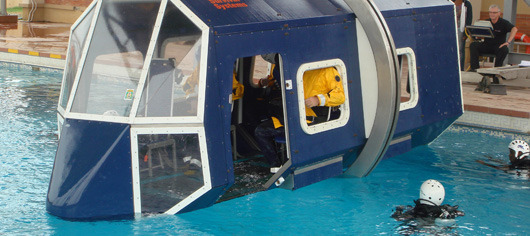
HUET MODULE FOR FOUR PASSENGERS
We were given full classroom instruction on HUET during the morning session. In the afternoon, we suited up for the actual exercise. The first layer of clothing is an ordinary coverall. Over that goes a survival suit, a lifejacket and an unique emergency breathing device called an Air Pocket Plus (APP). It’s used with a snorkel-like mouthpiece and allows you to breathe underwater using your own exhaled air (might sound odd, but it works.) Additionally everyone wears a helmet, and Crocs for the feet. In tropical climates like the Gulf of Guinea off Ghana’s coast, the survival suit is not used because it would simply be unbearably hot.
As we numbered fourteen, we were divided into three groups of four (the capacity of the module), and one of two. The lead-up to the ultimate drill, which would involve activating the lifejacket for flotation after escaping the craft, was preceded by gradual steps: being in the module at the water’s surface without submersion, followed by partial submersion, then full submersion without 180-degree capsize, and finally full submersion with capsize. Each group did each phase before proceeding to the next.
I have swum since I was a small boy, so am very comfortable in a pool environment. I must tell you, however, that this is a very different kettle of fish. I did fine up until the capsize, but on being turned upside down underwater, I quickly found myself wildly disoriented. The key is to never let go of the landmarks as the module makes its 180 rotation: your window, and your seatbelt. Open the window first, release the seatbelt second. I know that now, of course, but let’s just say that at the time I pretty much forgot those instructions and found myself flailing. I messed up royally on the first two submersion exercises and had to repeat one, but I’m happy to say that I forced mind over matter on the final maneuver, and managed to emerge okay, after which I activated my lifejacket. I wanted to go one more time, but the instructor and divers disallowed that. I think I had stressed them out quite enough.
Life imitating art
I wrote the scene in MAC3P involving Darko undergoing HUET before my own experience of it. It was remarkably, almost eerily, accurate. In fact, if you want a fuller description of what it was actually like to be underwater, you’ll find it in the fictional but, as it turns out, realistic scene in MAC3P. I’m not being coy. I think if I told all in this blog, it would act as a spoiler for those who intend to get my book. The next piece that will be subjected to reality testing is the scene with Darko on the oil rig, also written before the fact. How realistic is it, and how closely did life imitate art? We will find out on February 3rd.
January 19, 2014
AFTER THE CRASH: HOW TO ESCAPE FROM A SUBMERGED HELICOPTER (Part 1)
 In Murder at Cape Three Points, a canoe drifts into the restricted space around a deep sea oil rig carrying unusual cargo: two dead bodies. Charles Smith-Aidoo and his wife Fiona have been horrifically murdered with a signature bearing the hallmarks of a ritual killing. An oil rig in the Atlantic Ocean is not your run-of-the-mill crime scene, but it is still a crime scene and Inspector Darko Dawson, as thorough as he is, feels he must see it.
In Murder at Cape Three Points, a canoe drifts into the restricted space around a deep sea oil rig carrying unusual cargo: two dead bodies. Charles Smith-Aidoo and his wife Fiona have been horrifically murdered with a signature bearing the hallmarks of a ritual killing. An oil rig in the Atlantic Ocean is not your run-of-the-mill crime scene, but it is still a crime scene and Inspector Darko Dawson, as thorough as he is, feels he must see it.
Just one problem: the oil rig is some 37 miles off Ghana’s coast at Cape Three Points and one can only get there by chopper. One further detail: the oil company requires rig visitors to go through a 3-day BOSIET, Basic Offshore Safety Induction and Emergency Training. That includes HUET, Helicopter Underwater Egress (or Escape) Training, in which one is lowered into a pool in a mock helicopter cabin and turned upside down. Passengers then have to escape.
This might have been manageable if Darko could swim and wasn’t terrified of deep water. The thought of being dunked into a pool strikes fear in him like a stone cold statue in his chest, and if he gets through that, he then must face the real thing: crossing the vast Gulf of Guinea in a craft flying by dint of mysterious physics.
This author likes to experience exactly what his characters do–well, except the murders; not that part–so this MLK weekend, I’ll be attending that same training course that Darko did in Ghana, only I will be in Houston, TX (the course is standardized across the globe.) And this February when I go to Ghana, like Darko, I will cross that same magnificent Gulf of Guinea in a chopper that will touch down on the helipad of a deep sea oil rig–and not, I trust in the water.



